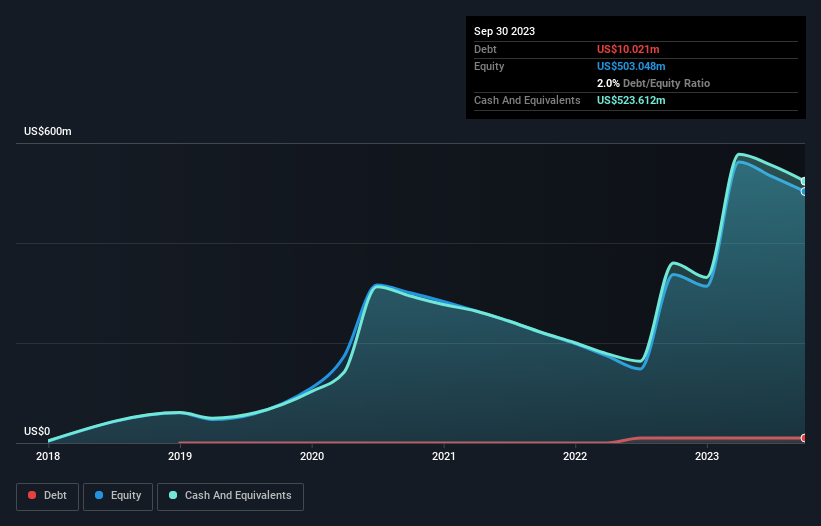
David Iben put it well when he said, 'Volatility is not a risk we care about. What we care about is avoiding the permanent loss of capital.' So it seems the smart money knows that debt - which is usually involved in bankruptcies - is a very important factor, when you assess how risky a company is. As with many other companies Pliant Therapeutics, Inc. (NASDAQ:PLRX) makes use of debt. But is this debt a concern to shareholders?
When Is Debt A Problem?
Debt assists a business until the business has trouble paying it off, either with new capital or with free cash flow. Part and parcel of capitalism is the process of 'creative destruction' where failed businesses are mercilessly liquidated by their bankers. While that is not too common, we often do see indebted companies permanently diluting shareholders because lenders force them to raise capital at a distressed price. Of course, debt can be an important tool in businesses, particularly capital heavy businesses. When we examine debt levels, we first consider both cash and debt levels, together.
View our latest analysis for Pliant Therapeutics
What Is Pliant Therapeutics's Debt?
The chart below, which you can click on for greater detail, shows that Pliant Therapeutics had US$10.0m in debt in September 2023; about the same as the year before. However, its balance sheet shows it holds US$523.6m in cash, so it actually has US$513.6m net cash.

How Healthy Is Pliant Therapeutics' Balance Sheet?
According to the last reported balance sheet, Pliant Therapeutics had liabilities of US$27.4m due within 12 months, and liabilities of US$10.0m due beyond 12 months. Offsetting these obligations, it had cash of US$523.6m as well as receivables valued at US$2.12m due within 12 months. So it actually has US$488.3m more liquid assets than total liabilities.
This excess liquidity is a great indication that Pliant Therapeutics' balance sheet is almost as strong as Fort Knox. With this in mind one could posit that its balance sheet means the company is able to handle some adversity. Simply put, the fact that Pliant Therapeutics has more cash than debt is arguably a good indication that it can manage its debt safely. When analysing debt levels, the balance sheet is the obvious place to start. But ultimately the future profitability of the business will decide if Pliant Therapeutics can strengthen its balance sheet over time. So if you want to see what the professionals think, you might find this free report on analyst profit forecasts to be interesting.
In the last year Pliant Therapeutics had a loss before interest and tax, and actually shrunk its revenue by 64%, to US$3.5m. To be frank that doesn't bode well.
So How Risky Is Pliant Therapeutics?
By their very nature companies that are losing money are more risky than those with a long history of profitability. And we do note that Pliant Therapeutics had an earnings before interest and tax (EBIT) loss, over the last year. And over the same period it saw negative free cash outflow of US$124m and booked a US$155m accounting loss. But the saving grace is the US$513.6m on the balance sheet. That means it could keep spending at its current rate for more than two years. Even though its balance sheet seems sufficiently liquid, debt always makes us a little nervous if a company doesn't produce free cash flow regularly. There's no doubt that we learn most about debt from the balance sheet. However, not all investment risk resides within the balance sheet - far from it. For example Pliant Therapeutics has 4 warning signs (and 1 which makes us a bit uncomfortable) we think you should know about.
If you're interested in investing in businesses that can grow profits without the burden of debt, then check out this free list of growing businesses that have net cash on the balance sheet.
If you're looking to trade Pliant Therapeutics, open an account with the lowest-cost platform trusted by professionals, Interactive Brokers.
With clients in over 200 countries and territories, and access to 160 markets, IBKR lets you trade stocks, options, futures, forex, bonds and funds from a single integrated account.
Enjoy no hidden fees, no account minimums, and FX conversion rates as low as 0.03%, far better than what most brokers offer.
Sponsored ContentNew: Manage All Your Stock Portfolios in One Place
We've created the ultimate portfolio companion for stock investors, and it's free.
• Connect an unlimited number of Portfolios and see your total in one currency
• Be alerted to new Warning Signs or Risks via email or mobile
• Track the Fair Value of your stocks
Have feedback on this article? Concerned about the content? Get in touch with us directly. Alternatively, email editorial-team (at) simplywallst.com.
This article by Simply Wall St is general in nature. We provide commentary based on historical data and analyst forecasts only using an unbiased methodology and our articles are not intended to be financial advice. It does not constitute a recommendation to buy or sell any stock, and does not take account of your objectives, or your financial situation. We aim to bring you long-term focused analysis driven by fundamental data. Note that our analysis may not factor in the latest price-sensitive company announcements or qualitative material. Simply Wall St has no position in any stocks mentioned.
About NasdaqGS:PLRX
Pliant Therapeutics
A biopharmaceutical company, discovers, develops, and commercializes novel therapies for the treatment of fibrosis and related diseases.
Excellent balance sheet slight.
Market Insights
Community Narratives



